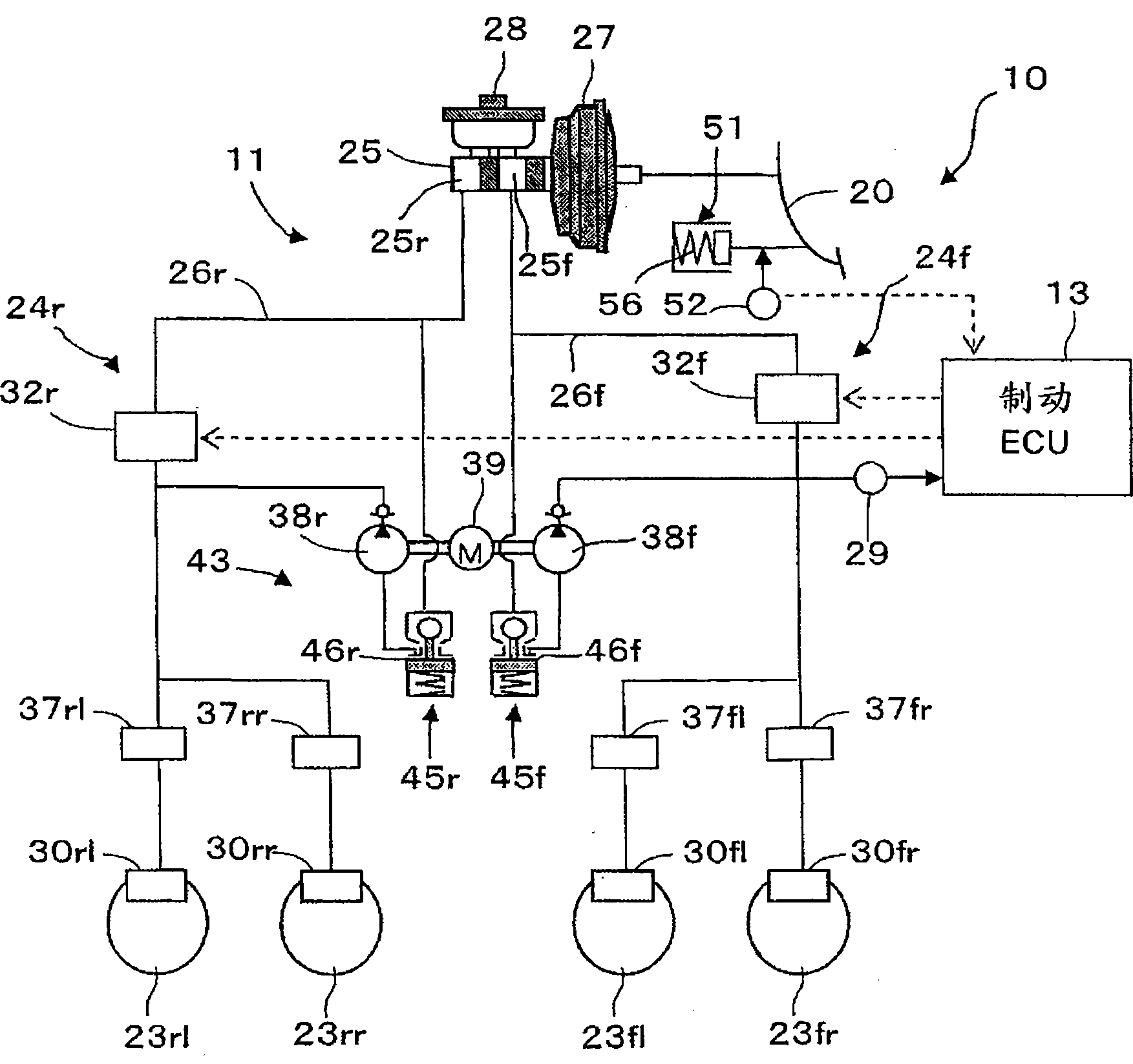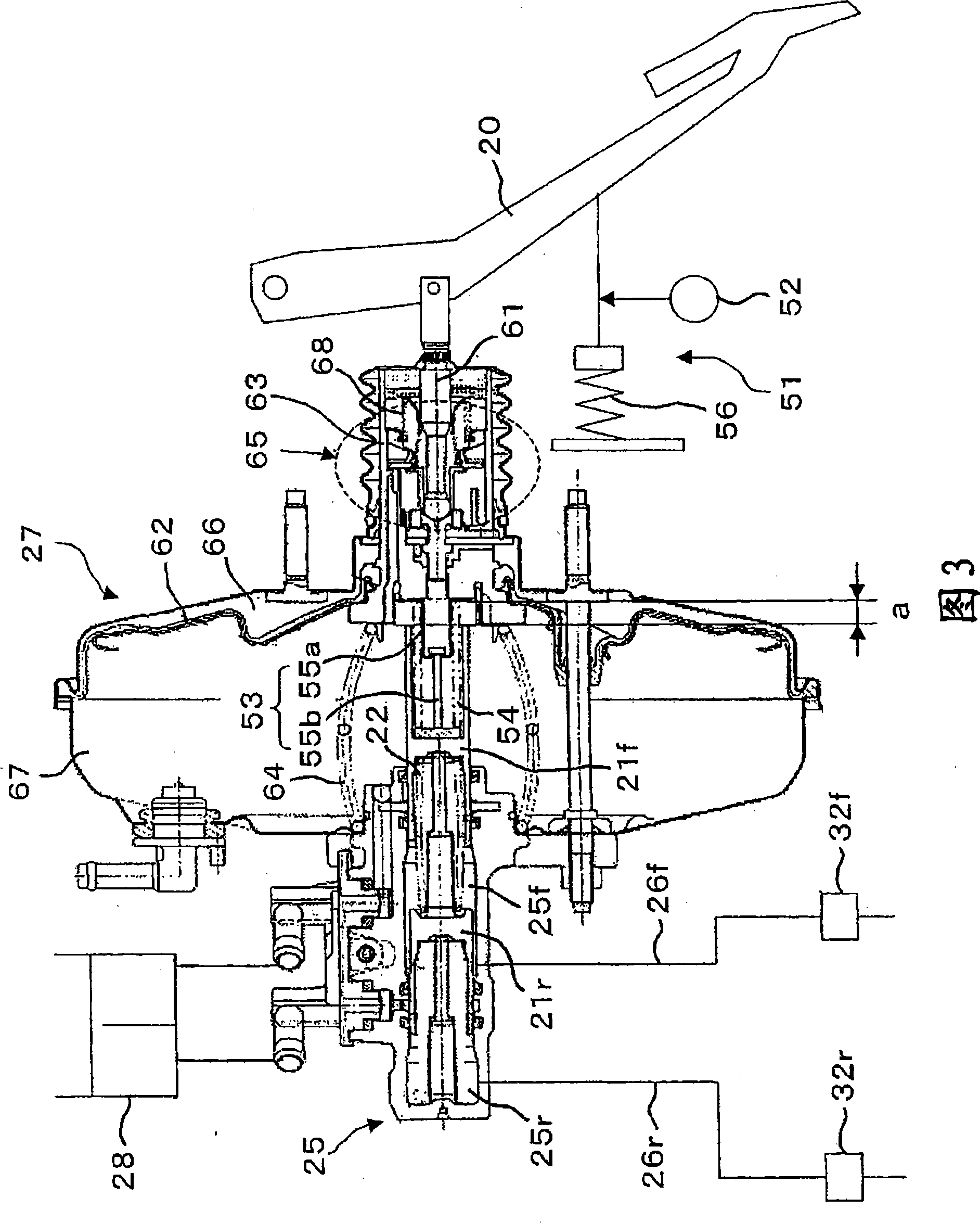Vehicle brake system
A technology of vehicle braking and wheel braking, which is applied in the direction of brakes, vehicle parts, braking transmission devices, etc., and can solve problems such as changes in brake pedals, larger differences in brake pedals, and drivers feeling uncomfortable
- Summary
- Abstract
- Description
- Claims
- Application Information
AI Technical Summary
Problems solved by technology
Method used
Image
Examples
no. 1 approach
[0030] A brake-by-wire type vehicle braking system according to a first embodiment of the present invention will be described below with reference to the drawings. see now figure 1 and figure 2 , a vehicle brake system generally designated by reference numeral 10 includes a hydraulic brake device 11 , an ECU 13 for controlling the hydraulic brake device 11 and the like.
[0031]The hydraulic brake device 11 is provided with a left front wheel brake 30fl and a right front wheel brake 30fr for the left front wheel 23fl and a right front wheel 23fr, and a left rear wheel brake 30rl and a right rear wheel brake 30rl for a left rear wheel 23rl and a right rear wheel 23rr. Wheel brakes 30rr. As known in the art, each of these brakes 30fl, 30fr and 30rl, 30rr is a disc brake or drum brake comprising at least one brake cylinder for operating brake shoes to limit the Rotation of the brake disc or drum (neither shown) which rotate with the tires. The configurations of the front whe...
no. 2 approach
[0058] Figure 6 Some components that are characteristic of the vehicle braking system according to the second embodiment of the present invention are shown. The brake system of the second embodiment differs from the brake system of the first embodiment described above in that a fluid absorbing mechanism 153 is used instead of the stroke absorbing mechanism 53 including the spring 54 and suspension members 55a, 55b, and the rubber disc 69 etc. are used to return the reaction force to the brake pedal 20, so that the device adopting the existing structure can be used as the vacuum type booster device 27. Therefore, parts different from those in the first embodiment will be described hereinafter, and parts identical to or identical to those in the first embodiment will be described below. Figure 6 are marked with the same reference numerals and will not be described in detail here.
[0059] Such as Figure 6 As shown, the fluid absorbing mechanism 153 is provided with a sumpe...
no. 3 approach
[0063] Figure 7 A partial circuit is shown as a feature of a vehicle braking system according to a third embodiment of the present invention. The brake system of the third embodiment differs from the brake system of the above-mentioned second embodiment only in that a restricting member 70 for restricting the flow of the fluid absorbed by the fluid absorbing mechanism 153 is added on the inlet side of the fluid absorbing mechanism 153 as a Free parts or blank parts. The restricting member 70 includes a fixed throttle valve 71 and a check valve 72 connected in parallel with the fixed throttle valve 71 for allowing fluid to flow only from the cylinder 57 to the channel 26r.
[0064] In the braking system of the third embodiment, when the driver suddenly performs a braking operation, the restricting member (throttle) 70 restricts the amount of brake fluid flowing into the cylinder 57, which results in restricting the absorption by the fluid absorbing mechanism 153. speed. As ...
PUM
 Login to View More
Login to View More Abstract
Description
Claims
Application Information
 Login to View More
Login to View More - R&D
- Intellectual Property
- Life Sciences
- Materials
- Tech Scout
- Unparalleled Data Quality
- Higher Quality Content
- 60% Fewer Hallucinations
Browse by: Latest US Patents, China's latest patents, Technical Efficacy Thesaurus, Application Domain, Technology Topic, Popular Technical Reports.
© 2025 PatSnap. All rights reserved.Legal|Privacy policy|Modern Slavery Act Transparency Statement|Sitemap|About US| Contact US: help@patsnap.com



